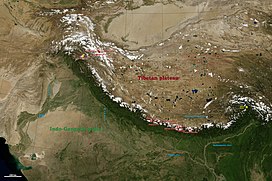
Back Himalaja Afrikaans Himalaya ALS ሂማላያ ተራሮች Amharic Himalaya AN हिमालय ANP هملايا Arabic هيمالايا ARZ হিমালয় Assamese Himalaya AST Гьималаял AV
| The Himalayas | |
|---|---|
 The arc of the Himalayas showing the eight-thousanders (in red); Indo-Gangetic Plain; Tibetan plateau; rivers Indus, Ganges, and Yarlung Tsangpo-Brahmaputra; and the two anchors of the range (in yellow) | |
| Highest point | |
| Peak | Mount Everest, Nepal/China |
| Elevation | 8,848.86 m (29,031.7 ft) |
| Coordinates | 27°59′N 86°55′E / 27.983°N 86.917°E |
| Dimensions | |
| Length | 2,400 km (1,500 mi) |
| Area | 595,000 km2 (230,000 sq mi) |
| Geography | |
 Map of the Himalayan-Hindu Kush region | |
| Countries | [a] |
| Continent | Asia |
| Geology | |
| Orogeny | Alpine orogeny |
| Rock age | Cretaceous to Cenozoic |
| Rock types | |
The Himalayas, or Himalaya (/ˌhɪməˈleɪ.ə, hɪˈmɑːləjə/ HIM-ə-LAY-ə, hih-MAH-lə-yə)[b] is a mountain range in Asia, separating the plains of the Indian subcontinent from the Tibetan Plateau. The range has several peaks exceeding an elevation of 8,000 m (26,000 ft) including Mount Everest, the highest mountain on Earth. The mountain range runs for 2,400 km (1,500 mi) as an arc from west-northwest to east-southeast at the northern end of the Indian subcontinent.
The Himalayas occupy an area of 595,000 km2 (230,000 sq mi) across six countries–Afghanistan, Bhutan, China, India, Nepal, and Pakistan. The sovereignty of the range in the Kashmir region is disputed among India, Pakistan, and China. It is bordered by the Karakoram and Hindu Kush ranges on the northwest, Tibetan Plateau in the north, and by the Indo-Gangetic Plain in the south. Its western anchor Nanga Parbat lies south of the northernmost bend of the Indus river and its eastern anchor Namcha Barwa lies to the west of the great bend of the Yarlung Tsangpo River. The Himalayas consists of four parallel mountain ranges: the Sivalik Hills on the south; the Lower Himalayas; the Great Himalayas, which is the highest and central range; and the Tibetan Himalayas on the north. The range varies in width from 350 km (220 mi) in the north-west to 150 km (93 mi) in the south-east.
The Himalayan range is one of the youngest mountain ranges on Earth and is made up of uplifted sedimentary and metamorphic rocks. It was formed more than 10 mya due to the subduction of the Indian tectonic plate with the Eurasian Plate along the convergent boundary. Due to the continuous movement of the Indian plate, the Himalayas keep rising every year, making them geologically and seismically active. The mountains consist of large glaciers, which are remnants of the last ice age, and give rise to some of the world's major rivers such as the Indus, Ganges, and Tsangpo–Brahmaputra. Their combined drainage basin is home to nearly 600 million people including 52.8 million living in the vicinity of the Himalayas. The region is also home to many endorheic lakes.
The Himalayas have a major impact on the climate of the Indian subcontinent. It blocks the cold winds from Central Asia, and plays a significant roles in influencing the monsoons. The vast size, varying altitude range, and complex topography of the Himalayas result in a wide range of climates, from humid and subtropical to cold and dry desert conditions. The mountains have profoundly shaped the cultures of South Asia and Tibet. Many Himalayan peaks are considered sacred across various Indian and Tibetan religions such as Hinduism, Buddhism, Jainism, and Bon. Hence, the summits of several peaks in the region such as Gangkhar Puensum, Machapuchare, and Kailash have been off-limits to climbers.
- ^ Cite error: The named reference
Britwas invoked but never defined (see the help page). - ^ Zurick & Pacheco 2006, p. 8–12.
- ^ "Himalayan". Oxford English Dictionary (Online ed.). Oxford University Press. Retrieved 1 June 2021.
Etymology: < Himālaya (Sanskrit < hima snow + ālaya dwelling, abode) + -an suffix)
(Subscription or participating institution membership required.)
Cite error: There are <ref group=lower-alpha> tags or {{efn}} templates on this page, but the references will not show without a {{reflist|group=lower-alpha}} template or {{notelist}} template (see the help page).